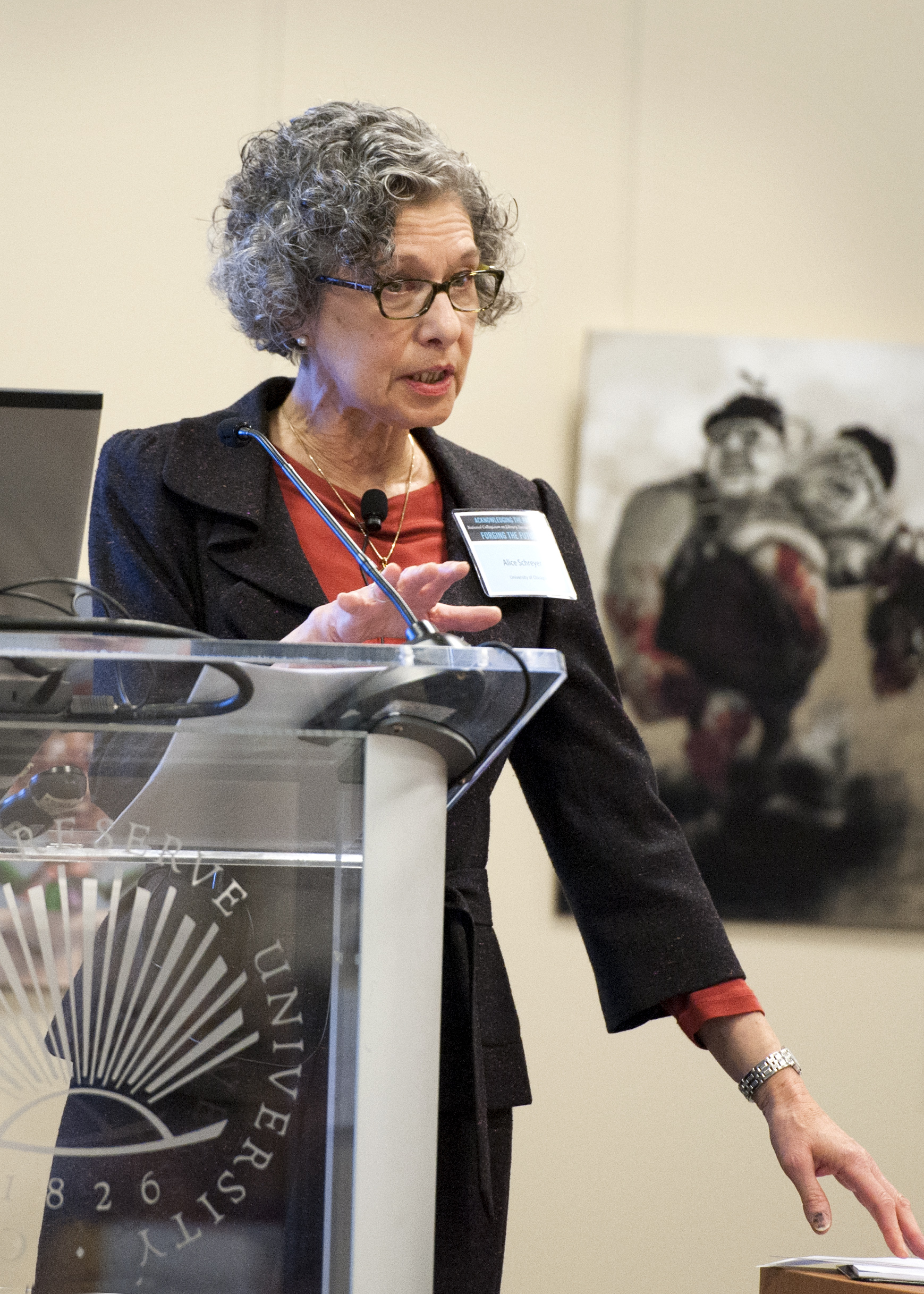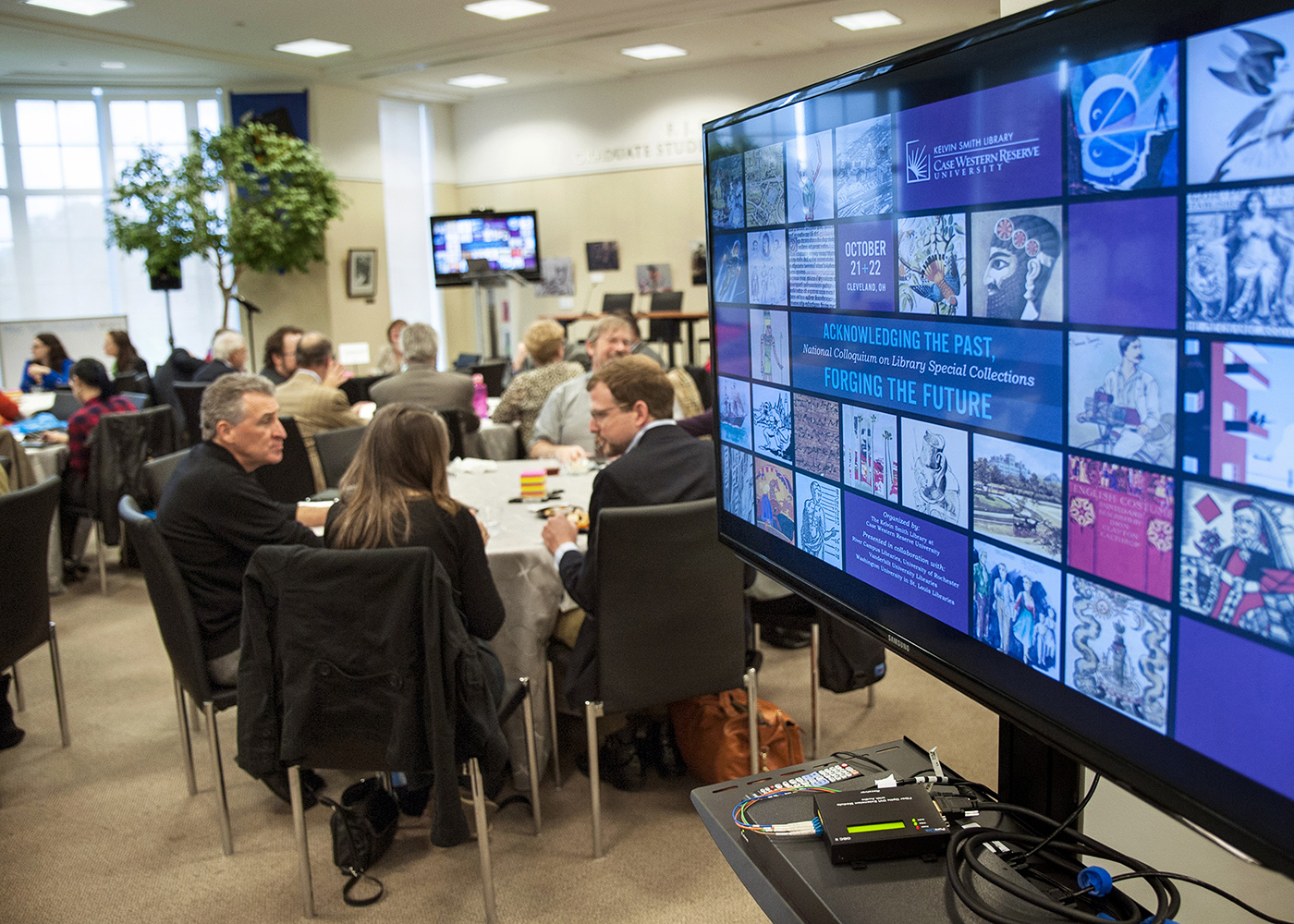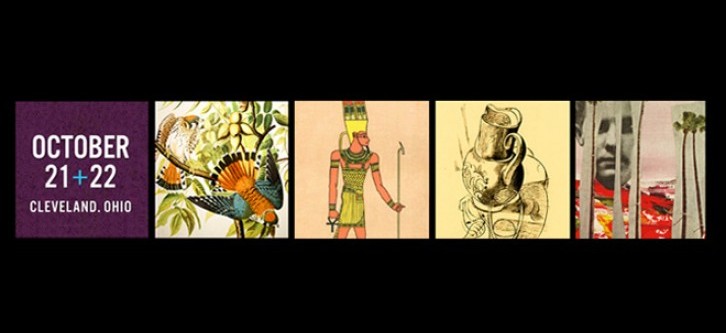Summary of a report by Terry Belanger on the conference
“Acknowledging the Past, Forging the Future: National Colloquium on Library Special Collections”
Organized by the
Kelvin Smith Library at Case Western Reserve University
21-22 October 2014
Rare book and special collections librarians tend to be creatures of habit, with traditional migratory patterns. They flock (1) to the annual Rare Books and Manuscripts Section (RBMS) pre-conference, generally held in late June, shortly before (2) the annual conference of the American Library Association (ALA); and – especially for mid-level members of the profession – (3) to ALA’s midwinter conference, generally held at the end of January, when it sometimes annoyingly competes with the various tribal shrieks of (4) Bibliography Week in New York City. Those on the archival side of the roost tend (5) to gather at the late-summer annual meeting of the Society of American Archivists (SAA), and there is always a substantial flight of librarians attending (6) the annual summer conference of the Society for the History of Authorship, Reading, and Publishing (SHARP) and the annual fall conference of the American Printing History Association (APHA).
Library salaries and institutional travel budgets being what they are, most members of the profession must pick which conferences in this clutch of treats they will attend, since few of them receive sufficient funding to go to everything, and fewer still wish to take the time off to do so, the more so because of the siren call of e.g. Rare Book School courses, which put further pressure on both migratory patterns and travel budgets.
Thus when notices began to appear this spring announcing a National Colloquium on Library Special Collections (“Acknowledging the Past, Forging the Future”) to be held in Cleveland in October 21st and 22nd, organized by the Kelvin Smith Library at Case Western Reserve University in collaboration with the River Campus Libraries of the University of Rochester, the Vanderbilt University Libraries, and the Libraries of Washington University in St Louis, many of the grown-ups in the profession wondered what was going on.
The roster of announced speakers included (among others – many others) Sarah Thomas (Harvard), Alice Schreyer (Chicago), Stephen Enniss (The Ransom Center), and Mark Dimunation (LC); speakers from the antiquarian book trade included Tom Congalton, Selby Kiffer, and Ken Lopez. Additional sponsors of the symposium included (among others – many others) the University of Illinois, Zubal Books, Aleph-Bet Books, the Antiquarian Booksellers’ Association of America (ABAA), Bruce McKittrick Rare Books, William Reese Company, and Rare Book School. With a cap of 200 attendees, the colloquium sold out in short order.

Alice Schreyer (Photo credit: Mike Sands photography)
A website informed attendees that the colloquium would:
“explore some of the factors that governed the growth and use of special collections of the past, as well as current and emerging challenges for special collections in the future. How can libraries and university faculty work together to educate students to become more aware of the hidden treasures that are available on their own campuses, and to gain a lifelong appreciation for them? How can collections from individual institutions work together to create a robust whole from the parts? How can scholars, libraries, potential donors, and collectors come together to forge new partnerships to employ these valued collections to advance knowledge and scholarship – particularly in a digital age? This colloquium will be a seminal event in acknowledging the historic strengths of special collections of the past, and for speakers and participants to chart a course for the next decade and beyond.”
The opening speakers at noon on Tuesday, October 21, explained what was going on in more simple terms: the desire by Cleveland bibliophile Robert Jackson to continue conversations begun at a memorable conference, held at the Library of Congress in 2001, on private collectors and special collections (the principal speakers were Mark Dimunation, William Reese, Alice Schreyer, and Jackson himself). In the early 1990s, Jackson took the lead in founding the Fellowship of American Bibliophilic Societies (FABS), and he has spoken frequently since then, pretty much all over the place, using his substantial personal resources to forward the cause of rare books, special collections, and archives in the overlapping worlds of antiquarian booksellers, book collectors, and rare book librarians and archivists. Since 2001, the attractions of digitization have become clamorous, archives is no longer a 97 pound-weakling, the middle has dropped out of the rare book market, and book collectors are younger, more heterogeneous, and less clubbable. This colloquium, said Jackson, was to be about forging our future: not waiting for it, but controlling and shaping it.
The structure of the colloquium program was quite simple:
Tuesday 21 October
11 am Registration and light lunch
12 noon Welcome (Arnold Hirshon and Robert Jackson)
12:30 pm Opening Keynote (Sarah Thomas)
Part I – THE PAST
1:30 pm Part I Keynote (Alice Schreyer)
2:30 pm coffee break
3 pm Part I Panel (Silver, Lopez, Ruxin, De Simone, Hawley)
Part II – THE PRESENT
4:30 pm Part II Keynote (Jay Satterfield)
5:30 pm Reception and dinner at the Western Reserve Historical Society
Wednesday 22 October
8 am Continental breakfast
9 am Part II Panel (Smith, Kiffer, Lindseth, Kuhn, Irmscher)
10:30 am break
Part III – THE FUTURE
10:45 am Part III Keynote (Stephen Enniss)
11:45 am lunch
1 pm Part III Panel (Cohen, Congalton, Jackson, Hubbard)
2:30 pm Closing Keynote (Mark Dimunation)
The relatively late start on the opening day of the colloquium enabled those who were commuting from home to drive fairly considerable distances to get to the conference opening on time without having to get up at the crack of dawn, or before. The alternation of keynotes and panels worked very well.
There was a list of the conference registrants in the colloquium program brochure, according to which There were no attendees listed with addresses in AK, HI, WA, OR, ID, NV, MT, WY, AZ, NM, ND, SD, NE, KS, OK, AR, WI, MS, SC; attendance from other distant states (even CA) was slight. Four Canadian provinces (BC, AB, SK, and ON) were represented.
The names of about 195 attendees were printed in the brochure. There were about 10 each collectors and dealers, five public librarians (good to see), and 11 representatives from IRLA libraries (including six from the Newberry). All of the Ivies except Penn showed up. College libraries were represented by Bowdoin, Kenyon, Lafayette, Oberlin, St Olaf, and Washington & Lee. About 30 of the registrants were from Case Western University itself, with several more from allied Cleveland institutions.
As these numbers suggest, Case Western library staffers were all over this conference, many of them working directly for it, and to considerable purpose; the logistics of this colloquium were very well thought out, and local arrangements were superb. Robert Jackson convened this colloquium, but it was clear that co-chair Arnold Hirshon (Associate Provost and University Librarian at Case Western) and his staff were the part of the iceberg that didn’t show.

Kelvin Smith Library (Photo credit: Mike Sands photography)
The conferees were to a considerable extent a regional crowd. The speakers were almost all (broadly speaking) from the East, though many of them certainly have national reputations.
My suspicion is that an unusually large percentage of the colloquium attendees paid their own way, in part because of the short lead time (the conference was first widely announced on in the spring of 2014) and the resulting difficulty of inserting unexpected conference expenses into academic budgets at short notice.
So: what was different, if anything, about this conference, and was it worth attending?
The colloquium was well-funded; the location was attractive. AV support was strong and competent; the food was good; the program brochure was comprehensive and handsomely designed (it even included color photographs of all of the presenters). The colloquium’s theme was focused, and the speakers stuck to business; there was very little slack in their presentations. The keynotes were uniformly excellent, with the laurels for charm going to Jay Satterfield (half the crowd was wishing that JS was *their* special collections librarian by the end of his presentation). Most of the panel presenters spoke from notes; notable among those with fully-prepared texts were Haven Hawley, the collectors, and the dealers.
Immediately after Stephen Enniss gave his “Charting the course to the future” keynote, the President of Case Western Reserve University (CWRU), Barbara R. Snyder, spoke to the colloquium for about ten minutes. She said that since Librarian Arnold Hershon came to CWRU in 2010, there have been ongoing discussions about increasing student/library relations. More recently, the university has been thinking about library facilities supporting CWRU’s new health education campus, being built in conjunction with the Cleveland Clinic. The plan is to place librarians throughout the building to integrate them into the life of the school: a librarian will be right there when an idea comes up. CWRU is not closing its health sciences library – but they’re not duplicating it, either. The plan is experimental, BS said; it wouldn’t work at the law school!
How do you strike the right balance? she asked. CWRU has a partnership with the Cleveland Museum of Art (right down the street); a new center for art history is planned, supporting a dramatically re-imaged, artifact-based, art history doctoral program. She is aware of the many challenges of digitization in the university, and she congratulated the colloquium attendees for their willingness to deal with them: “your efforts center on some of the most meaningful aspects of what universities are doing,” she concluded.
Another coup for the conference organizers: how many of us could have secured the services of our university president for such an occasion?
The colloquium’s charge stated, in part, an intent to be “a seminal event in acknowledging the historic strengths of special collections of the past, and for speakers and participants to chart a course for the next decade and beyond.” The “past” at this colloquium turned out to be the very recent past; virtually nothing was said by anyone about special collections before the 1970s; even the term “rare book” seldom came up. The colloquium’s dominant themes were:
General
- Even if you have a ticket, you may not know where you’re going
- We need increased inter-institutional collaboration
- We don’t do collaborative acquisitions, but should
- The challenges and difficulties of scale (boutique vs Google-Books)
- Licensing problems; copyright problems
- Who will maintain locally unneeded/unwanted special collections?
Digitization
- Digitization efforts continue to dominate the landscape
- Digitization may decrease onsite use
- Access to digitized materials is spotty; just because we put stuff online doesn’t mean people will find it
- The most interest part of authors’ digital archives may be their email correspondence
- Less-processing more-product continues to be a dominant mantra
Acquisitions
- Collectively, library acquisitions budgets are still formidable
- The number of collectors may have shrunk, but there are still plenty of them around
- Collectors are shifting to highlights (rather than completist) collecting
- Donors will continue to give collections to libraries so long as the US tax law on gifts remains unchanged
- The current emphasis in special collections is more on the use of currently owned materials than on acquiring new materials, and the acquisition of archives is more fashionable than the acquisition of printed books
- We want the collections we bring in to be used
Use
- Students *really* like working with original materials of the sort found in special collections
- Show-and-tell sessions in special collections are less useful than more imaginative approaches in presenting materials to students
- Special collections increasingly focus on intra-institution instruction
- Lady-Bountiful approaches in dealing with underserved communities don’t work
Strategies
- Academic collections must be relevant to the teaching curricula
- Books and archives are most meaningful when attached to stories
- In dealing with prospective donors, special collections libraries need to adopt a yes/yes but/no unless/no approach
- Our bosses may have a different take on the our collections from ours; proceed with caution
- We need more model policies, best practices guides
- Special collections libraries need to continue to promote themselves, and as widely as possible
- There are all sorts of tools already out there (cf ALADN)
- The web talks back to you: listen to what it says
Personnel
- Descriptive bibliography is still an important skill, even if English departments don’t think so
- The pool of currently available, experienced special collections librarians is lumpy
- We are going to see more special collections librarians with hyphenated skill sets
l’Envoy
- Don’t forget the public library collections
- Don’t forget that this is fun
Click here to read Terry's full report on the conference.




